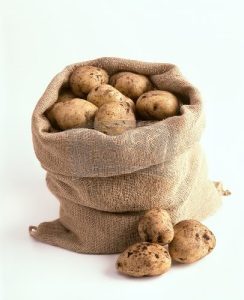How To Store Potatoes For Long Periods Of Time
The potato is one the most commonly used vegetables in the world. It has high nutritional value, as it contains antioxidants, potassium, vitamin C and starch. If you’re the type of person that knows his potatoes and can’t get enough of them, I’ll show you how to make provisions to last for long periods of time.
The best containers for storing potatoes are the burlap bags (hessian sacks). This type of material is excellent for storing spuds, because during storage, the vegetables release moisture. The moisture is easily released and the potatoes breathe easily through the hessian fibers. Storage should be light-free, as light will cause the accumulation of solanine, alkaloids and chaconine.
A quick note from our founder –
Over the past year, my friend Dave at PaleoHacks has been working on a secret cookbook with world-renowned Le Cordon Bleu chef Peter Servold.
That’s right – as a special launch promotion, we’re offering our brand new Paleo fat loss cookbook to you for free (Chef Pete lost 60 lbs using these recipes!) – All you have to do is just cover a small shipping cost (international shipping is a bit more).
These substances are poisonous and should be avoided. They are not potentially fatal, but they can induce a state of sickness. Affected potatoes that have been exposed to the sun are easy to spot, as they tend to turn green. The process can be reversed if a spud is affected on less them 1/3 of its area. During storage it will gradually return to normal, and if the green color on the skin or flesh of the potato persists after storage, simply cut it off and discard it. If the affliction is spread on more than 1/3, the potato should not be stored or eaten, but thrown away immediately.

Hessian sacks are available at every garden supplier. As an alternative, paper bags are almost just as good. Old pillowcases can serve the same purpose, as long as you happen to have any lying around. Potatoes should under no circumstances be stored in plastic bags or transparent material, as they will easily spoil from the light and the moisture!
If you’re planning on reusing old burlap bags, you should definitely washed them first. Even if the last year’s batch was 100% successful, washing the sacks is a requirement. Don’t thrown them in the washing machine, but rather soak them for a couple of hours in hot soapy water, to which you previously added a splash of bleach. The bleach will sterilize and make the sacks safe for re-usage.
Once you have the potatoes all sorted out and the bags ready for storage, you can deposit them in a cool and dark spot. The ideal temperature for storing potatoes is 42 to 50°F. Going over the recommended temperature is not as bad as going under 42°F, because bellow this temperature the starch begins to turn to sugar, giving the spuds an unpleasantly sweet taste. This process is reversible if you keep them at warmer temperatures (70°F) for a week or two. If for some reason or another the temperature should drop below or around freezing point, the potatoes will soften and will immediately rot as soon as the temperature begins to rise.
Stored potatoes should be checked periodically, once or twice a month. Take your time and inspect each one at a time.
There you have it: the best and safest way of storing potatoes. Follow through exactly and you’ll have no problems in keeping them fresh. There are other writings out there that suggest throwing in each bag a handful of pesticide pellets. Sorry but this sounds insane. I’m strongly discouraging you to use these vermin pellets while storing potatoes, as this method has never been scientifically proven and could have dire consequences for your health!Blight is very common amongst stored spuds and can spread very fast throughout the storage area. If you’re unsure whether a potato is affected or not, you should smell it. Blight has a very distinctive smell and you’ll know right away. If you happen to notice flies around your burlap bags but can’t seem to find anything wrong with you’re vegetables, check them by hand. In some cases, rot spots tend to develop under the skin. If you feel soft spots, the potato started to rot from the inside. Flies have ways of detecting the rot and will react as a consequence, making them a good indicator.



